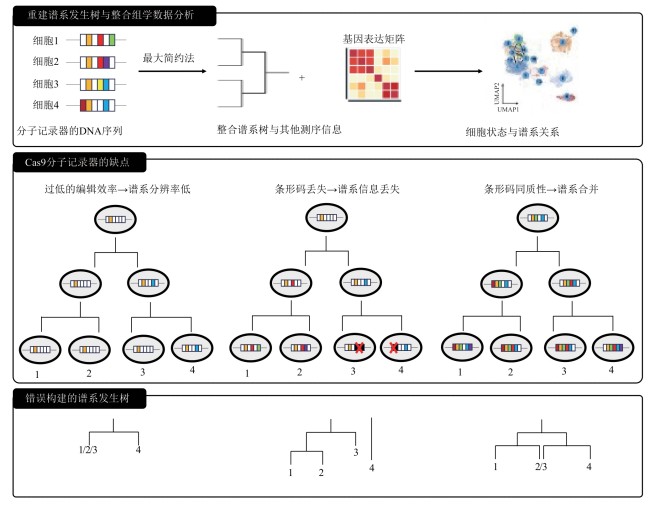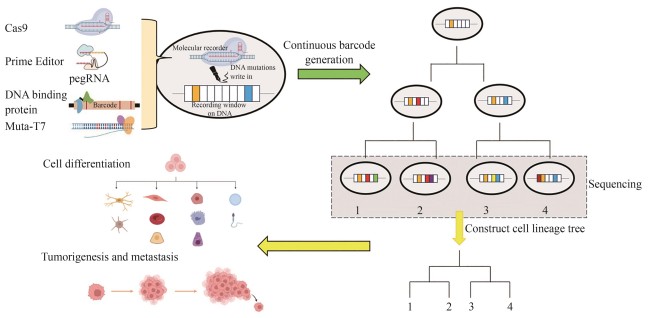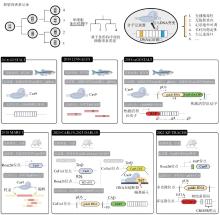|
||
|
Application and prospect of live cell DNA-based molecular recorders in cell lineage tracing
Synthetic Biology Journal
2025, 6 (3):
651-668.
DOI: 10.12211/2096-8280.2024-082
Tracing the division and differentiation history of cells is a critical issue in organismal development and cancer research. Live cell DNA-based molecular recorders, a synthetic system that induces heritable DNA variations, offers an innovative approach for reconstructing cell lineage histories. As a representative for the new generation of cell lineage tracing method, this system can be integrated with high-throughput single-cell sequencing and multi-omics analysis, enabling the reconstruction of developmental differentiation pathways of cells and the phylogenetic trees of tumorigenesis as well. Live cell DNA-based molecular recorders serve as an effective platform for exploring these core biological processes. This review systematically analyzes the technological evolution of Cas9-based molecular recorders in lineage tracing since 2016 and its applications, while also analyzing the research trends of some novel molecular recorders and evaluating their advantages and limitations. Since 2016, molecular recorders based on the CRISPR-Cas9 system have made significant progress and gradually become the mainstream technology in this field. However, Cas9-based molecular recorders still suffer from several inherent limitations, such as the low lineage resolution due to insufficient editing efficiencies, the loss of recorded information caused by DNA double-strand breaks, and potential lineage merging due to barcode homoplasy. These limitations pose challenges for researchers to explore and develop new types of molecular recorders as more efficient and precise tools for cell lineage tracing. Novel molecular recorders based on new principles, such as prime editors, DNA-binding protein-fused base editors, and T7 RNA polymerase-fused base editors, can avoid DNA double-strand breaks and record information through base substitutions rather than deletions. Compared to the Cas9 system, they exhibit unique advantages but also come with potential risks and challenges. Prime editors can record information in a temporal sequential manner, but off-target effects remain a concern. DNA-binding protein-fused base editors offer high editing efficiencies and specificities, but their effectiveness across different cell types requires further exploration. T7 RNA polymerase-fused base editors have achieved success in in vivo directed evolution systems, but their application in mammalian systems is still limited. In the future, the research of DNA-based molecular recorders should focus on optimizing editing efficiency, reducing information loss, improving lineage recovery efficiency, and exploring their application potentials in complicated biological systems.

Fig. 2
Reconstructed phylogeny trees and integrated omics data analysis[
Extracts from the Article
自2016年以来,人们在应用这项新技术的同时,也认识到其具有明显的缺陷,其主要是由CRISPR-Cas9系统在细胞内产生DNA双链断裂的固有特点造成的。首先,Cas9引起的DNA条形码主要以碱基缺失(deletions)形式存在,缺失可能会导致条形码发生丢失或简并现象,干扰谱系发生树的建立。其次,Cas9的编辑效率并不能保证在一次分裂的时间内,对每个细胞中都至少引入一个编辑,也就会导致时间分辨率的下降。另外,编辑窗口窄,即可被编辑的位点少,这也会导致条形码发生简并现象,干扰谱系发生树的建立[3](图2)。因此,在后续的研究中,不同研究组纷纷开发了各种不同的方法来提高谱系追踪技术的编辑效率、时间分辨率和编辑稳定性。
细胞谱系数据解析是一个高度复杂且多层次的分析流程,涵盖了从数据预处理、亚克隆识别、谱系发生树构建到验证和解释的多个步骤,我们在这部分详细介绍如何用生物信息学手段从分子记录器产生的数据中重建谱系发生树,以及多组学数据(尤其是单细胞组学数据)如何与细胞谱系分析相结合,获得对生物学问题的更深层次理解(图2)。
先导编辑(prime editing)是一种新型基因组编辑技术,通过替换目标DNA中的特定序列,实现精准的基因修改.其基本原理是利用融合了反转录酶的nCas9(nicking Cas9,在靶位点引起单链DNA切口的Cas9变体蛋白),结合特定的先导编辑引导RNA(prime editing guide RNA, pegRNA),在指定位置诱导单链断裂.pegRNA不仅包含用于反转录的编辑序列,还包括结合序列,从而实现精准的DNA替换、插入和删除,无需引入双链断裂或供体DNA模板.这种机制确保了高效的基因组编辑,克服了传统基因编辑中常见的旁观者编辑和脱靶效应等问题,同时最大限度地减少了不必要的基因组干扰[ Molecular recording of mammalian embryogenesis 5 2019 ... 自2016年以来,人们在应用这项新技术的同时,也认识到其具有明显的缺陷,其主要是由CRISPR-Cas9系统在细胞内产生DNA双链断裂的固有特点造成的.首先,Cas9引起的DNA条形码主要以碱基缺失(deletions)形式存在,缺失可能会导致条形码发生丢失或简并现象,干扰谱系发生树的建立.其次,Cas9的编辑效率并不能保证在一次分裂的时间内,对每个细胞中都至少引入一个编辑,也就会导致时间分辨率的下降.另外,编辑窗口窄,即可被编辑的位点少,这也会导致条形码发生简并现象,干扰谱系发生树的建立[
Other Images/Table from this Article
|


